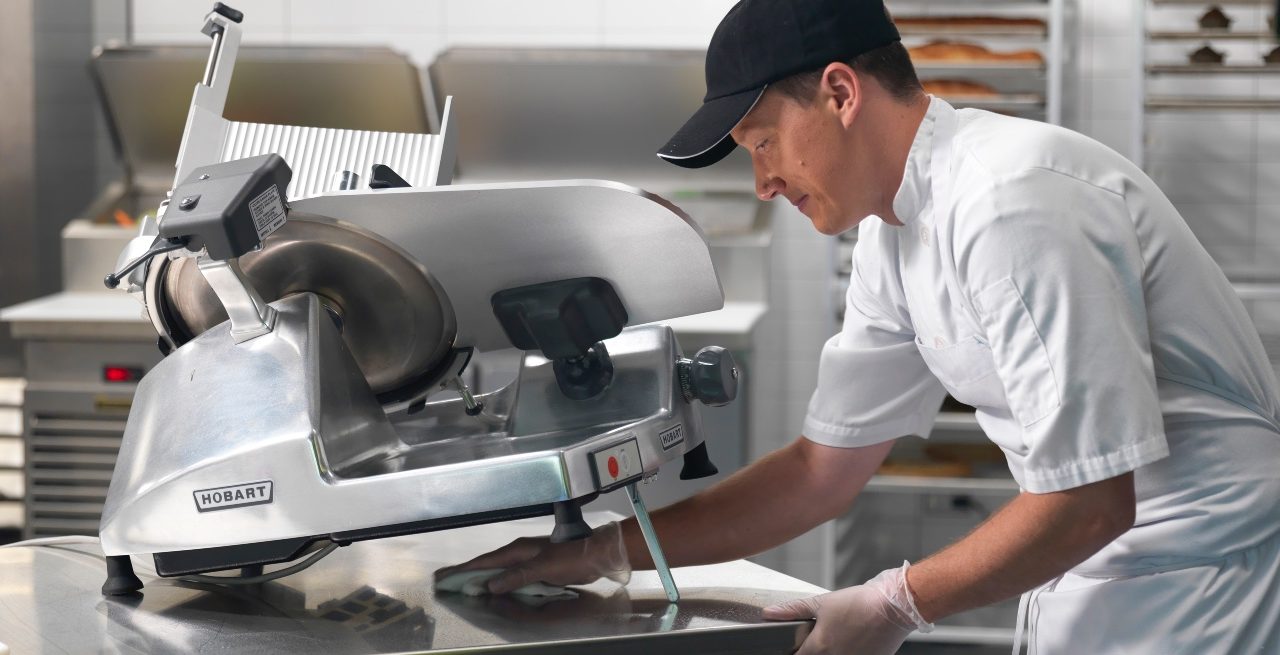Best Practices for Care and Cleaning of Food Prep Equipment
5 Min Read By Carolyn Bilger
When it comes to keeping a restaurant kitchen running smoothly, it’s important to have properly trained staff, reliable procedures and effective communication. It’s also critical to have equipment that is well cared for and cleaned correctly on a regular basis. That includes food prep equipment like mixers, food processors and slicers.
Following some best practices for care and cleaning not only helps support the longevity of the equipment, but it also helps ensure staff has equipment that can produce consistent, high-quality food output. Fortunately, the processes don't have to be complicated or time-consuming. When planned out carefully, it’s possible to take routine care measures, as well as clean and sanitize equipment, with minimal downtime and no interruption to food prep or service.
Remember to always unplug food prep equipment prior to any care or cleaning! Never hose down mixers, food processors or slicers, as it will damage the electrical components.
Mixer Care Know-Hows
As a first order of business, inspect the mixer daily for any damage or loose parts that could negatively impact the equipment’s performance. Staff can do this at the start or end of a shift. Part of the inspection should include checking the bowl clearance to be certain the agitator isn’t hitting the bowl’s bottom, which can cause wear on both components. An inconsistent bowl-to-agitator ratio can also prevent the mixer from incorporating ingredients properly. If adjustments are necessary or if any damage has been identified, refer to the manufacturer’s operating manual for guidance or contact a professional service provider for assistance or parts replacement.
Thoroughly clean the mixer after mixing different ingredients or recipes and at the end of the day. Wipe the mixer base with a clean, damp cloth, taking care to remove any residual food from under the planetary. This is a common spot for ingredients to accumulate. After wiping down the mixer, use a spray sanitizer and allow the mixer to air dry. Do not use too wet of a cloth since it can cause damage to the control panel or cause water to get under knobs. Also, take care not to overclean the slideway where the bowl moves up and down. It can remove grease that is necessary for smooth bowl movement. Wash the bowl, agitator and bowl guard in a three-compartment sink with soapy water, clear water and sanitizer. These components on some mixers, according to the manufacturer’s directions, may be safe to clean in a commercial dishwasher. Check the operator’s manual.
Caring for Food Processors
Like mixers, it’s important to carefully inspect a food processor daily — whether it is acontinuous-feed, bowl-style or combination-style model. Look for damage to the blades sincethose are at the heart of these machines and responsible for ensuring consistent processing.Replace as needed. (As an aside, continuous-feed food processors are used to dice, grate, slice and shred fruits, vegetables, cheese, nuts and more, while a bowl-style machine chops, minces, mixes and emulsifies. A combination model is capable of both types of processing.)
For all three types of food processors, wipe down the base of the machine and clean after processing different ingredients. Doing so helps minimize the risk of cross-contamination and reduces the opportunity for food-borne bacteria to settle in any seams on the machine.
Note, if a continuous-feed food processor is being used for fruits and vegetables, it is acceptable to clean the machine regularly throughout the day without fully disassembling it. Wipe out the hopper and rinse the blade or cutting tool in between processing. If staff processes cheese or nuts, they should go through the full cleaning process, as follows. Full cleaning is also necessary for bowl- and combination-style machines after mixing and emulsifying ingredients, for example.
As with cleaning a mixer in between various ingredient processing or at the end of the day, disassemble removable parts and carefully wash in a three-compartment sink or place dishwasher-safe parts in a commercial warewash machine, according to the manufacturer’s instructions. Typically, food processor blades can be cleaned in a dishwasher.
If staff chooses to handwash blades, it is critical it is done with care. They should never placemultiple blades into a three-compartment sink. Rather, they should keep the blades in a container until they are ready to wash them and do so one at a time to avoid injury. Place the blades on a drying rack after rinsing and then store them on wall hooks when they are dry to prevent damage. This storage method also makes it easy to find the right blade when it’s needed.
The Slice on Slicer Care
Some restaurants rely on a slicer to slice fresh meats and cheeses for menu items, and staff must take care with these machines for two key reasons. Not only is the blade sharp on this machine, but also it is easy for the slicer to harbor food-borne bacteria without proper cleaning and sanitizing.
Staff can clean slicers periodically throughout the day and in between product without breaking the machine down completely. Tip the slicer carriage back and wipe it and the gauge plate down with a clean, damp cloth.
Some slicers have removable blades that can be cleaned in a dishwasher for deep cleaning at the end of a day. Other removable parts can also be cleaned in a dishwasher or three-compartment sink, depending on the manufacturer’s recommendation. During the deep cleaning process, staff should clean the remainder of the machine by hand, wiping down parts (including underneath the slicer) with a clean, soapy cloth, followed by spraying it with a manufacturer-approved sanitizer.
If a slicer does not have a removable blade, it will be necessary to clean with a flossing technique. This requires staff to weave a damp, soapy cloth carefully around the blade to remove any food debris; a gentle back and forth movement is recommended. Use a sanitizingspray as a final step.
As with mixers and food processors, it is also important to visually inspect slicer parts daily for any damage, addressing accordingly with in-house maintenance or by contacting a service provider.
Preventive Maintenance and More
In addition to inspecting, cleaning and sanitizing, regular preventive maintenance (PM) is another key aspect of caring for food prep equipment. PM helps support the longevity of thesemachines and ensure they perform properly. Consult operator manuals and contact the equipment service provider to determine the necessary PM steps and frequency to keep mixers, food processors and slicers in top shape.
To gain a better understanding of both the care and operation of food prep equipment, kitchen staff can also look to a manufacturer’s website for resources for help. These typically include videos, literature, wall charts and copies of operator manuals that can be an invaluable part of training and daily use of the machines.


